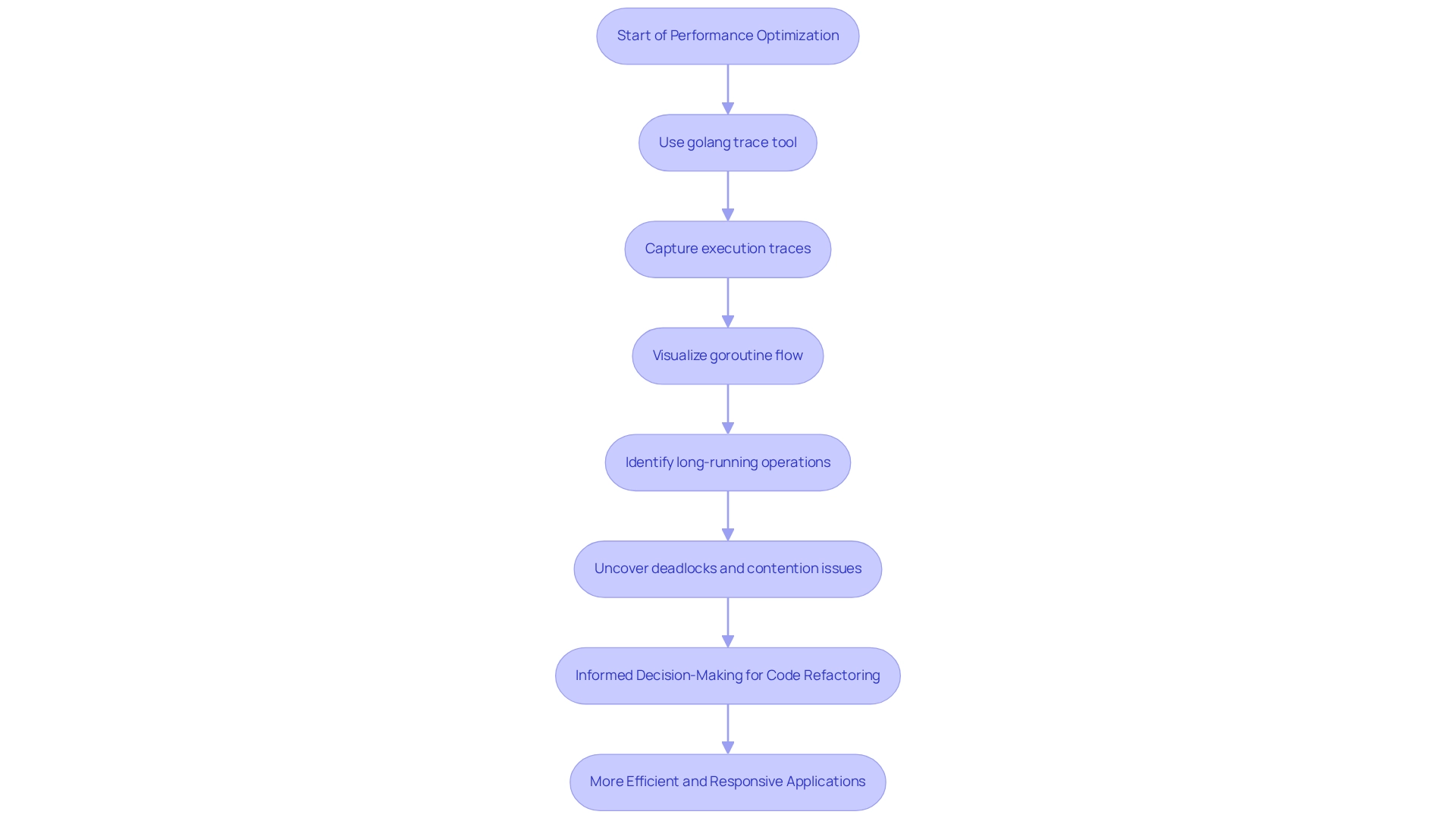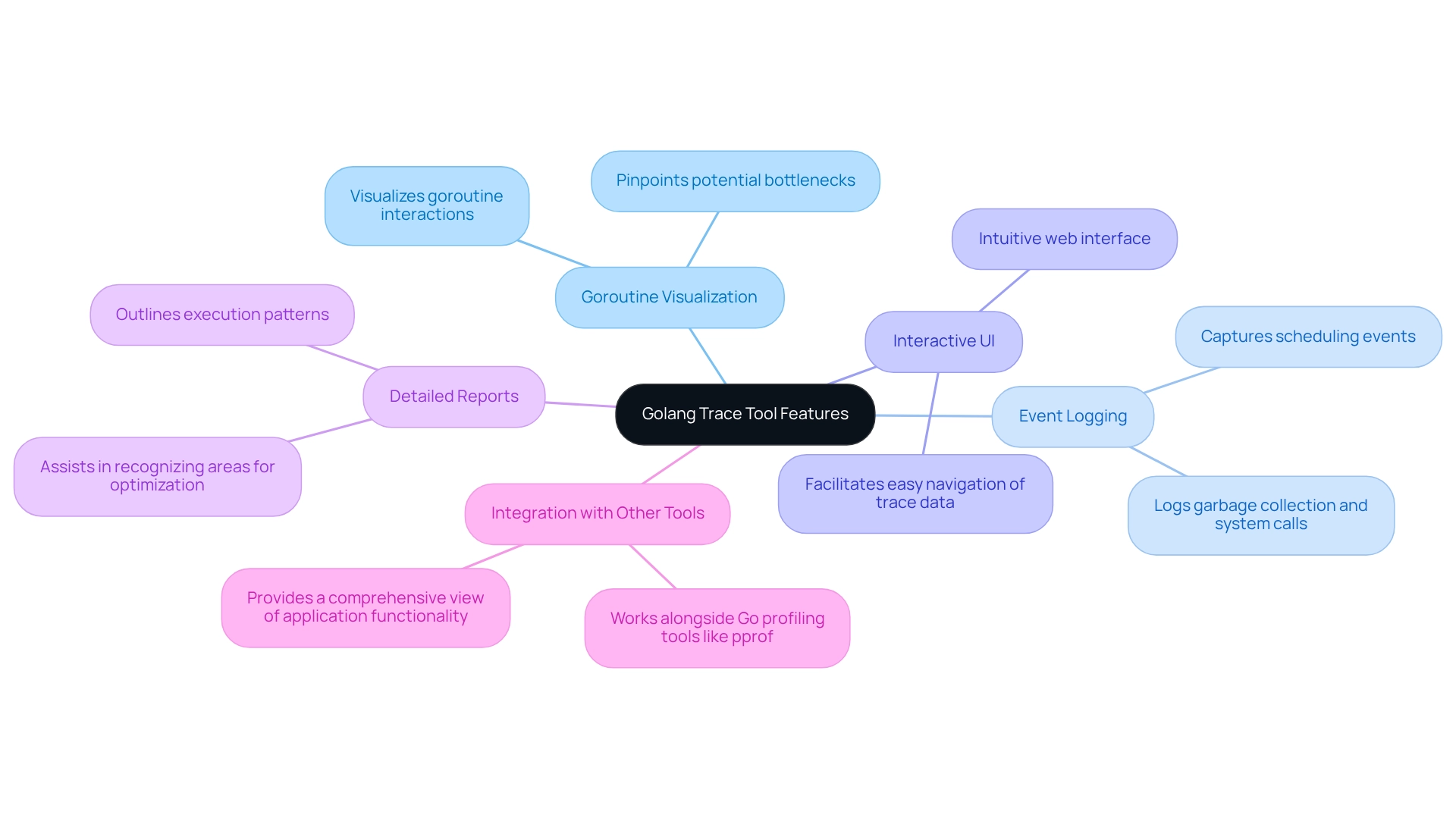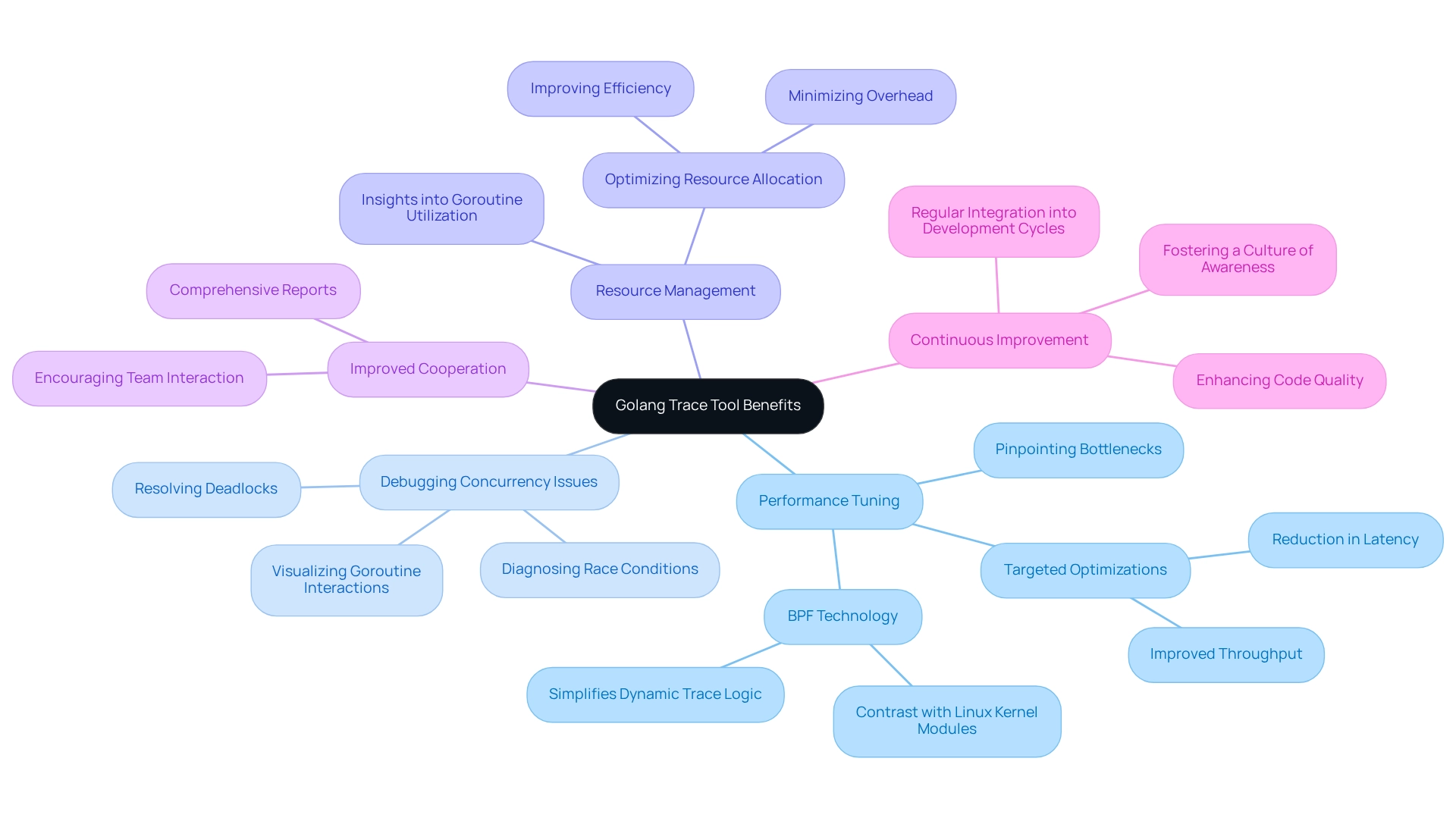Overview
Developers often face significant challenges when it comes to optimizing their code and understanding complex concurrency patterns. The Golang Trace Tool serves as a vital resource, capturing and visualizing the execution of Go programs. This innovative tool addresses these coding challenges through features like goroutine visualization and event logging. By providing critical insights, it empowers developers to identify performance bottlenecks effectively.
Imagine being able to pinpoint inefficiencies in your applications effortlessly. The Golang Trace Tool not only enhances your understanding of concurrency but also significantly boosts your overall productivity. With its ability to log events and visualize goroutines, developers can optimize application performance and streamline their workflow.
Why not take advantage of such a powerful diagnostic tool? By utilizing the Golang Trace Tool, you can enhance your coding practices, leading to improved performance and efficiency. Explore the features available and see how they can transform your development process.
Introduction
In the fast-evolving landscape of software development, developers often grapple with significant challenges related to performance optimization. How can they ensure their applications are both efficient and responsive? The Golang Trace Tool emerges as a powerful ally in addressing these coding challenges. By capturing detailed execution traces, this diagnostic tool enables developers to visualize goroutine interactions and identify performance bottlenecks.
Furthermore, it empowers them to tackle concurrency issues head-on, enhancing the overall user experience. As organizations strive to maximize resource efficiency, the significance of the Golang Trace Tool becomes increasingly evident. It offers invaluable insights that drive informed decision-making and foster a culture of continuous improvement in coding practices.
Define Golang Trace Tool
Coding challenges are a common hurdle for developers, often leading to inefficiencies and frustration. The golang trace tool, which is part of the Go programming language's runtime/trace package, serves as a powerful diagnostic resource that captures and visualizes the execution of Go programs. By recording extensive details about goroutines, scheduling events, and system calls, this tool enables developers to identify efficiency bottlenecks and understand concurrency patterns.
Furthermore, the Golang Diagnostic Instrument plays a crucial role in troubleshooting intricate applications, particularly when issues arise from concurrency problems or resource contention. As Tony Hoare, a renowned computer scientist, wisely noted, "We should forget about small efficiencies, say about 97% of the time: premature optimization is the root of all evil." This perspective underscores the importance of focusing on efficiency without falling prey to the pitfalls of early optimization, a challenge that the golang trace tool effectively addresses.
In addition to this, tools like Kodezi enhance programmer efficiency through automated code debugging. They facilitate quick identification and resolution of codebase problems, tackle efficiency hindrances, and ensure compliance with security best practices. Imagine how much time could be saved by using such tools to streamline your workflow!
As programmers increasingly adopt the Golang Monitoring Utility alongside Kodezi, their significance in enhancing application efficiency and dependability continues to grow. Why not explore the tools available on the platform and discover how they can transform your coding experience?
Contextualize Its Role in Performance Optimization
In software development, performance optimization is crucial for enhancing user experience and maximizing resource efficiency. Have you ever wondered how developers tackle the challenges of application performance? The golang trace tool is essential in this process, offering programmers critical insights into application execution over time. By capturing detailed execution traces, it enables developers to visualize the flow of goroutines, pinpoint long-running operations, and uncover potential deadlocks or contention issues. This data is essential for informed decision-making regarding code refactoring and optimization strategies, ultimately resulting in more efficient and responsive applications.
Furthermore, statistics indicate that 29% of teams have effectively adopted practices from both Scrum and Kanban, highlighting a shift towards more agile methodologies that prioritize results. In addition, specialists emphasize the importance of initiating projects earlier to accelerate completion. This underscores the necessity for resources such as the golang trace tool, which aids in the early identification of efficiency issues. Real-world applications of the golang trace tool illustrate its effectiveness in enhancing efficiency. Case studies demonstrate substantial advancements in application responsiveness and user satisfaction. As Michael Feathers points out, a culture of testing is essential for maintaining code quality. The insights offered by the golang trace tool support this culture by enabling programmers to recognize and tackle efficiency issues proactively. As we look ahead to 2025, the significance of performance enhancement in software creation continues to grow, making the golang trace tool indispensable for programmers aiming to improve application efficiency and user satisfaction.

Trace Tool Origin and Evolution
In the realm of concurrent programming, developers often face significant challenges that can hinder productivity. The necessity for enhanced diagnostics, a defining characteristic of the Go language, led to the emergence of the golang trace tool. Since its introduction in the early iterations of Go, this tool has evolved considerably, shaped by user feedback and advancements within the language. Initially designed for basic tracing functions, it now boasts sophisticated features such as interactive visualizations and comprehensive event logging. This continuous improvement underscores Go's commitment to equipping developers with robust performance analysis resources, reinforcing its essential role in the Go ecosystem.
Similarly, Kodezi addresses these challenges with innovative solutions like the Kodezi CLI. This versatile tool enables teams to auto-heal codebases in seconds, significantly enhancing programming productivity. It reflects the collaborative spirit necessary for tackling modern development challenges. As Jordan Leath, Director of Marketing at Kodezi, stated, "We are inviting the community to join us on this transformative journey as we continue to push the boundaries of what’s possible." This sentiment resonates with the evolution of the golang trace tool, which has progressed in response to user community requirements.
Furthermore, case studies such as SAMHSA's campaign illustrate how diagnostic instruments can adapt to community needs and research, similar to the advancements seen with the golang trace tool. The key aspects of Kodezi's solutions, such as their capacity to optimize workflows and elevate code quality, highlight the importance of these tools in contemporary programming settings. They strengthen the monitoring system's function in boosting programmer productivity.
Are you ready to explore how Kodezi can transform your coding experience? Discover the tools available on the platform and see the difference for yourself.
Key Features and Functionalities
In the world of software development, programmers often face significant challenges that can hinder their efficiency and the effectiveness of their applications. The golang trace tool addresses these challenges with a robust set of features designed to enhance productivity and streamline processes.
- Goroutine Visualization is one of its standout features, offering a graphical representation of goroutines. This allows developers to visualize interactions and pinpoint potential bottlenecks in real-time.
- Event Logging captures a wide range of events, including scheduling, garbage collection, and system calls, providing a detailed view of application behavior that is invaluable for troubleshooting and optimization.
- The tool also boasts an Interactive UI, which presents an intuitive web interface, enabling users to navigate trace data with ease. This facilitates the analysis of metrics and helps in identifying issues promptly.
- Furthermore, the Detailed Reports generated by the analysis utility outline execution patterns, assisting developers in recognizing specific areas for enhancement and optimization.
- Additionally, the tool's Integration with Other Tools is seamless, working alongside other Go profiling tools like pprof to deliver a comprehensive view of application functionality. This integration is crucial for programmers aiming to achieve peak effectiveness in complex scheduling scenarios, as evidenced by case studies from Air France's Operations Research team, which utilized advanced modeling techniques to improve operational efficiency.
Moreover, Kodezi's automated code debugging capability significantly enhances the monitoring feature, allowing programmers to quickly detect and resolve issues within the codebase. This ensures compliance with the latest security best practices and coding standards, ultimately optimizing the CI/CD pipeline for rapid issue resolution and code enhancement.
As developers increasingly seek resources that provide extensive tracking functionalities, the golang trace tool stands out for its ability to deliver actionable insights into goroutine behavior and application performance. This not only enhances decision-making but also boosts efficiency in software creation. As Florent Chané, Project Manager at ESUPS, aptly stated, "If you give them the tools to enter their own data, complete their own analysis, and make their own decisions, then they can control their logistics, and in turn, their response to disaster." This underscores the importance of equipping programmers with effective resources like the golang trace tool. It is also essential to note that some diagnostics tools in Go may interfere with one another; thus, using them in isolation is recommended for more precise information.

Practical Applications and Benefits
Coding challenges can often hinder developers' progress, but the practical uses of the golang trace tool offer extensive solutions, establishing it as an essential resource for programmers. Key benefits include:
- Performance Tuning: By pinpointing performance bottlenecks, developers can implement targeted optimizations that significantly enhance application responsiveness. Studies indicate that effective optimization can lead to a reduction in latency and improved throughput, particularly in high-load scenarios. Significantly, BPF technology streamlines dynamic trace logic development in contrast to conventional Linux kernel module implementations, making optimization more attainable.
- Debugging Concurrency Issues: The tool is invaluable for diagnosing complex concurrency challenges, such as race conditions and deadlocks, which can be notoriously difficult to identify. Its ability to visualize goroutine interactions aids in swiftly resolving these issues.
- Resource Management: Gaining insights into how goroutines utilize system resources enables developers to optimize resource allocation, thereby minimizing overhead and improving overall efficiency. This understanding is crucial for applications that handle large datasets or require high concurrency.
- Improved Cooperation: The comprehensive reports produced by the Tracking System encourage better interaction among team members, providing a clear understanding of application functionality. This openness fosters a cooperative atmosphere where challenges can be tackled together.
- Continuous Improvement: Regularly integrating the Trace Tool into development cycles fosters a culture of awareness regarding results, encouraging programmers to prioritize optimization in their coding practices. This proactive approach not only enhances code quality but also contributes to long-term project success.
As Dmitry Vyukov, the tracer author, notes, "As of Go 1.12, go tool trace supports graphing Minimum mutator utilization, which is useful for analyzing the impact of garbage collectors on application latency and throughput." This capability is especially significant for programmers concentrated on optimization.
In real-world applications, the impact of optimizing inefficient algorithms has been documented in the case study titled "Impact of Inefficient Algorithms on Performance." This research emphasizes how recognizing and refining ineffective algorithms can significantly enhance application efficiency and resource management. As developers increasingly utilize the golang trace tool, they can expect to see improved application efficiency and a more streamlined development process. Furthermore, the framework's integration as an open-source Trace Compass extension indicates ongoing developments that will further enhance its utility in exploring performance anomalies in microservice systems.

Conclusion
The Golang Trace Tool is an essential asset for developers facing the challenges of performance optimization in software development. It offers features such as:
- Goroutine visualization
- Event logging
- An interactive UI
These capabilities empower developers to gain critical insights into application behavior, pinpoint bottlenecks, and effectively diagnose concurrency issues. They enhance debugging efforts and contribute to a more collaborative and transparent development environment.
Furthermore, the tool's evolution reflects the growing need for sophisticated diagnostics in concurrent programming, making it increasingly indispensable as applications scale in complexity. By integrating tools like Kodezi, developers can streamline their workflows, ensuring adherence to best practices while fostering a culture of continuous improvement.
The cumulative benefits of utilizing the Golang Trace Tool extend beyond immediate performance gains; they promote a proactive approach to optimization, contributing to the long-term success of software projects.
As the landscape of software development continues to evolve, the Golang Trace Tool remains at the forefront, equipping developers with the tools necessary to enhance application performance and user experience. Embracing this tool is not merely about addressing current challenges; it is about preparing for the future of efficient and responsive software solutions.
Frequently Asked Questions
What is the golang trace tool?
The golang trace tool is a diagnostic resource within the Go programming language's runtime/trace package that captures and visualizes the execution of Go programs. It records details about goroutines, scheduling events, and system calls to help developers identify efficiency bottlenecks and understand concurrency patterns.
How does the golang trace tool assist in troubleshooting applications?
The golang trace tool helps troubleshoot applications by providing insights into concurrency problems and resource contention. It captures detailed execution traces that allow developers to visualize the flow of goroutines, identify long-running operations, and uncover potential deadlocks or contention issues.
What is the significance of focusing on efficiency in programming?
Focusing on efficiency is crucial for enhancing user experience and maximizing resource efficiency. It is important to avoid premature optimization, as highlighted by Tony Hoare, who noted that focusing on small efficiencies too early can lead to significant issues in development.
How can tools like Kodezi improve programmer efficiency?
Tools like Kodezi enhance programmer efficiency through automated code debugging, allowing for quick identification and resolution of codebase problems. They help tackle efficiency hindrances and ensure compliance with security best practices, ultimately streamlining the workflow for developers.
What role does the golang trace tool play in performance optimization?
The golang trace tool plays a vital role in performance optimization by providing critical insights into application execution. It helps developers make informed decisions regarding code refactoring and optimization strategies, leading to more efficient and responsive applications.
What are some benefits of adopting agile methodologies in software development?
Agile methodologies, such as Scrum and Kanban, emphasize results and allow teams to initiate projects earlier, which can accelerate completion. The adoption of these practices can lead to improved efficiency and responsiveness in application development.
How does the golang trace tool contribute to a culture of testing?
The insights provided by the golang trace tool support a culture of testing by enabling programmers to proactively recognize and address efficiency issues. This helps maintain code quality and improves overall application performance.
Why is the golang trace tool considered indispensable for programmers?
The golang trace tool is considered indispensable for programmers aiming to improve application efficiency and user satisfaction, especially as the significance of performance enhancement in software creation continues to grow.




